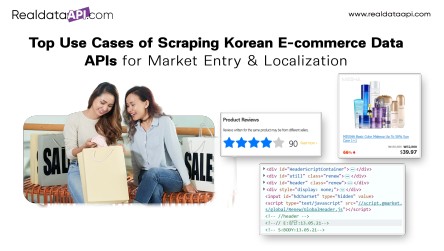


Discover how Korean E-commerce Data APIs support market entry, product localization, pricing, and consumer insights for success in Korea’s online market.
Introduction
South Korea’s digital marketplace is fast, mobile-first, and fiercely competitive. Platforms such as Naver Shopping, Coupang, Gmarket, and 11Street set the pace, each generating torrents of product, price, and consumer-behavior data. For global brands and cross-border sellers, winning here means going far beyond translating a website—it means harnessing live, granular insights through a Korean E-commerce Data API. Done right, scraping delivers the facts behind every trend spike, price drop, and review surge, giving businesses the immediacy they need to localize quickly and accurately.
Language & Culture Alignment – Korean shoppers respond to nuance in phrasing, imagery, and benefits. Raw data reveals which words, visuals, and bundles actually convert.
Platform Dominance – Local sites, not Amazon, rule the market; monitoring Naver Shopping and Coupang is essential.
Rapid Trend Cycles – From Pepero Day to K-beauty fads, consumer tastes shift week to week. Real-time feeds keep merchandising and marketing nimble.
Key takeaway: Scraping isn’t optional if you want pricing, content, and demand signals timed to Korea’s uniquely fast ecommerce clock.
Product Trend Analysis
Scrape Naver Shopping search charts to spot emerging SKUs or categories before they crest. Seasonal surges around Chuseok or graduation season become visible days in advance, guiding inventory buys and ad creative.
Competitive Price Tracking
Hourly price monitoring across 11Street, SSG.com, and Gmarket uncovers flash discounts and coupon wars. Adjust campaigns or automated repricers so you’re never caught over- or under-priced.
Localized Copy & Keyword Extraction
Pull top-performing titles and bullet points from Coupang listings to craft benefit-driven, native-sounding descriptions—far more persuasive than machine translation alone.
Sentiment Mining in Reviews
Korean reviews often include delivery speed, unboxing photos, and durability notes. Running sentiment analysis on thousands of comments shows which features delight or disappoint by region, age group, or usage context.
Competitor Launch Surveillance
Tracking catalog updates lets you know when rivals drop new colorways or limited editions. Match their timing or fill assortment gaps they leave open.
Logistics Benchmarking
Extract delivery promises and refund terms from Rocket Delivery or Market Kurly listings. Use these benchmarks to negotiate with 3PLs and set service-level agreements Korean shoppers expect.
Dynamic Pricing for K-Beauty & Fashion
K-beauty shades and apparel sizes sell out quickly. Scraped variant-level data reveals real-time demand curves, helping planners redirect stock or trigger replenishment.
Quick Commerce Insights
Apps like Baedal Minjok and Coupang Eats show spikes in meal or grocery orders by hour. Hyperlocal scraping down to the postal-code level informs menu rotation or micro-fulfillment placement.
Reseller & Parallel Import Detection
Identify unauthorized sellers using your images or trademarks. Early detection enables prompt takedown requests, preserving brand equity and MAP compliance.
AdTech Synchronization
Feed live SKU data into Naver or Kakao ad platforms. Rotating copy to mirror trending keywords or stocking status can boost click-through and cut wasted spend.
Naver Shopping: Trend signals, price comparisons, rich reviews
Coupang: High-volume product data, delivery metrics, user photos
Gmarket & 11Street: Competitive pricing, catalog breadth
Market Kurly & SSG.com: Grocery, K-beauty, and premium fashion
Baedal Minjok: Restaurant listings and delivery dynamics
Scraping several platforms in tandem paints a full-spectrum view of the Korean consumer journey, from search to doorstep.
Respect robots.txt, terms of service, and personal-data laws. Whenever official APIs exist, integrate them. Store scraped content securely and avoid extracting unnecessary PII. Partnering with an experienced, ethics-first provider minimizes legal and reputational risk.
Define Targets: Choose platforms tied to your niche—electronics, fashion, groceries, or beauty.
Select Tools: Adopt ready-made scraping APIs or custom crawlers optimized for Korean layouts and language.
Integrate & Act: Pipe structured data into dashboards, pricing engines, or BI tools so merchandising and marketing teams can act in real time.
South Korea offers outsized growth for brands that move as quickly as its consumers. A robust Korean E-commerce Data API turns raw marketplace activity into clear, timely intelligence—guiding dynamic pricing, precise localization, faster launches, and superior customer experiences. The brands that thrive here scrape ethically, analyze relentlessly, and iterate without delay. Ready to unlock Korean market insights? Engage an expert data partner today and start making decisions at the speed of Seoul’s digital storefronts.
Source: https://www.realdataapi.com/top-use-cases-of-scraping-korean-e-commerce-data-apis.php
Originally Published By: https://www.realdataapi.com
#KoreanEcommerceDataAPI #ScrapingKoreanEcommerceData #KoreaEcommerceAPI #KoreanEcommerceMarketEntry #KoreanMarketLocalization #KoreanProductDataScraping #NaverShoppingDataScraping #CoupangScraperAPI
